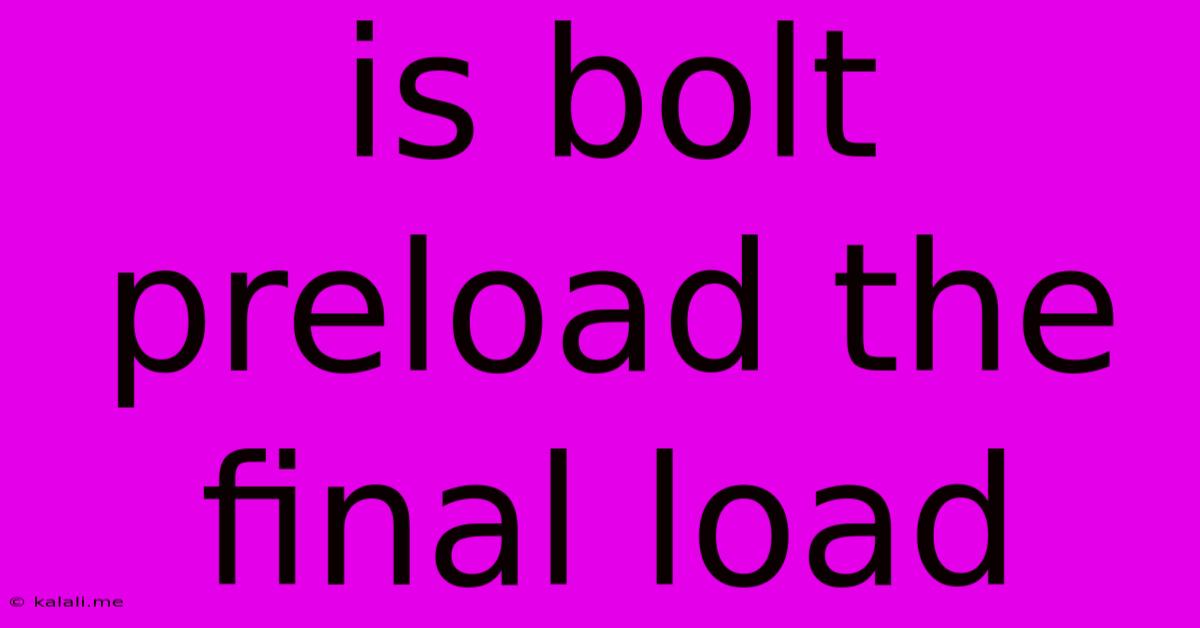Is Bolt Preload The Final Load
Kalali
Jun 05, 2025 · 3 min read

Table of Contents
Is Bolt Preload the Final Load? Understanding Bolt Tension and Load Capacity
Meta Description: This article clarifies the relationship between bolt preload and final load, explaining why preload isn't the final load and exploring the crucial role of preload in ensuring joint integrity and preventing failures. We'll delve into the factors affecting bolt load and how to properly calculate and maintain optimal tension.
Bolt preload is a critical aspect of mechanical engineering, often misunderstood as the final load a bolt endures. This couldn't be further from the truth. While preload is crucial for establishing joint integrity and strength, it represents only the initial clamping force applied to the joint before any external loads are applied. The final load experienced by a bolt is the combined effect of the preload and any external forces acting on the joint. This article will unravel the complexities of bolt loading and help you understand this critical distinction.
What is Bolt Preload?
Bolt preload is the tensile stress applied to a bolt before external loads are imposed. It's achieved by tightening the bolt to a specific torque, creating a clamping force that squeezes the joined components together. This clamping force is what prevents relative movement between the components under load. Proper preload is essential for ensuring the joint’s strength and durability. Insufficient preload can lead to joint loosening, vibrations, and ultimately, failure. Conversely, excessive preload can cause bolt yielding or fracture.
Why Preload Isn't the Final Load
The final load on a bolt is the sum of the preload and the external load applied to the joint. Consider a simple example: a bolted flange connection subjected to pressure. The initial preload holds the flange faces together. When pressure is introduced, the external load tries to separate the flanges. This external load is added to the initial preload. Therefore, the bolt experiences a higher tension which represents the final load. If the bolt’s design and preload aren't sufficient to handle this combined load, failure can occur.
Several factors influence the final load experienced by a bolt:
- External Load: This is the force applied to the joint after the bolt is tightened, such as tensile, shear, or bending forces.
- Preload Variation: Achieving consistent preload across multiple bolts in a connection is challenging, and variations introduce inconsistencies in the final load distribution.
- Material Properties: The material properties of the bolt and joined components (elastic modulus, yield strength, etc.) significantly impact the stress distribution and the final load capacity.
- Friction: Friction between the bolt threads, the washer, and the joined surfaces affects the torque-to-preload relationship and consequently the final load.
- Temperature Changes: Temperature fluctuations can impact bolt length and consequently reduce the effective preload.
Calculating and Maintaining Optimal Preload
Calculating the required preload involves understanding the design requirements, material properties, and the anticipated external load. Various methods are employed, ranging from simple torque calculations to sophisticated finite element analysis. Precise torque wrenches and load indicators play a crucial role in achieving the target preload consistently.
Regular inspection and maintenance are crucial to ensure that the preload remains within the acceptable range. Factors like vibration, corrosion, and thermal cycling can gradually reduce the preload, thereby compromising joint integrity. Periodic retorquing or bolt replacement might be necessary to maintain the desired preload.
Conclusion: Understanding the Complete Load Picture
In conclusion, bolt preload is essential but not the final load. The actual load carried by the bolt is the combination of preload and external loads. Accurate preload calculation, quality control during assembly, and routine inspection are critical to ensure the long-term reliability and safety of bolted connections. A thorough understanding of these principles helps to prevent unexpected failures and ensure structural integrity.
Latest Posts
Latest Posts
-
What Is Cc On A Motorcycle
Jun 06, 2025
-
How Do You Paint Parking Lot Lines
Jun 06, 2025
-
How To Get Rid Of Crazy Ants
Jun 06, 2025
-
How Can I Keep Dogs Out Of My Yard
Jun 06, 2025
-
3 Speed Fan Switch Wiring Diagram
Jun 06, 2025
Related Post
Thank you for visiting our website which covers about Is Bolt Preload The Final Load . We hope the information provided has been useful to you. Feel free to contact us if you have any questions or need further assistance. See you next time and don't miss to bookmark.